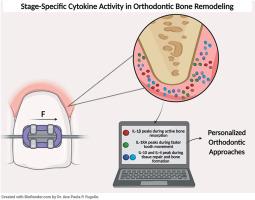Proinflammatory and anti-inflammatory cytokines in modulating bone remodeling during orthodontic tooth movement
引用次数: 0
Abstract
Objectives
This systematic review and meta-analysis sought to assess the influence of proinflammatory (interleukin [IL]-1β, IL-6, tumor necrosis factor α) and anti-inflammatory (IL-10, IL-4, IL-1RA) cytokines on bone remodeling during orthodontic tooth movement. The aim was to clarify their dynamics over time and space and evaluate their potential as clinical biomarkers.
Search Strategy
The review adhered to the Preferred Reporting Items for Systematic reviews and Meta-analyses 2020 guidelines. A structured population, intervention, comparator, outcome framework directed the search. Medical Subject Heading terms alongside free-text key words were used in combination with Boolean operators across various databases (PubMed, Embase, Scopus, Cochrane Library, Web of Science) from 2000 through 2024. The reference lists of the included studies were examined manually to ensure thoroughness.
Citation Sources
Searching electronic databases and conducting manual reference checks resulted in an initial collection of 85 studies of which 14 met the criteria for inclusion.
Study Selection Criteria
The studies eligible for inclusion measured cytokine levels (IL-1β, IL-10, IL-1RA, IL-4) in gingival crevicular fluid, saliva, or serum throughout orthodontic treatment. No age, sex, or appliance type restrictions were imposed on the participants. Both observational and interventional human studies were considered.
Data Elements Included
Data extraction included details such as authorship, methodology, biological fluid examined, cytokines investigated, detection technique (enzymed-linked immunosorbant assay, multiplex assay, polymerase chain reaction), sample size, and key outcomes. Quality assessment was conducted using the Newcastle-Ottawa Scale.
Overall Conclusions
Proinflammatory cytokines showed early peaks after the application of orthodontic force, triggering bone resorption at compression sites. In contrast, anti-inflammatory cytokines appeared later, facilitating repair and bone deposition at tension sites. IL-1β levels were positively correlated with the rate of tooth movement, while lower levels of IL-1RA were associated with quicker distal displacement. Although the pooled results from the meta-analysis did not show statistically significant differences, consistent trends supported the regulatory role of cytokines in orthodontic tooth movement. Future investigations should focus on larger, multicenter studies using standardized protocols to confirm the reliability of cytokines as biomarkers for precise orthodontic treatments.

促炎和抗炎细胞因子在正畸牙齿运动过程中调节骨重塑
目的本系统综述和荟萃分析旨在评估促炎因子(白介素[IL]-1β、IL-6、肿瘤坏死因子α)和抗炎因子(IL-10、IL-4、IL- 1ra)对正畸牙齿移动过程中骨重塑的影响。目的是澄清它们随时间和空间的动态变化,并评估它们作为临床生物标志物的潜力。检索策略:本综述遵循2020年系统评价和荟萃分析指南的首选报告项目。结构化的人群、干预、比较、结果框架指导了研究。从2000年到2024年,在各种数据库(PubMed, Embase, Scopus, Cochrane Library, Web of Science)中,医学主题标题术语与自由文本关键字结合使用布尔运算符。人工检查纳入研究的参考文献列表,以确保完整性。引文来源搜索电子数据库并进行手动参考检查,初步收集了85项研究,其中14项符合纳入标准。研究选择标准在整个正畸治疗过程中测量龈沟液、唾液或血清中的细胞因子水平(IL-1β、IL-10、IL-1RA、IL-4),符合纳入条件的研究。参与者没有年龄、性别或器具类型的限制。考虑了观察性和介入性人体研究。数据提取包括作者、方法、检测的生物液、细胞因子、检测技术(酶联免疫吸附试验、多重试验、聚合酶链反应)、样本量和关键结果等细节。使用纽卡斯尔-渥太华量表进行质量评估。结论正畸力施加后,促炎性细胞因子出现早期峰值,促进压迫部位骨吸收。相反,抗炎细胞因子出现较晚,促进张力部位的修复和骨沉积。IL-1β水平与牙齿移动速度呈正相关,而IL-1RA水平越低,远端移动速度越快。虽然meta分析的汇总结果没有显示统计学上的显著差异,但一致的趋势支持细胞因子在正畸牙齿运动中的调节作用。未来的研究应该集中在更大的、多中心的研究上,使用标准化的方案来确认细胞因子作为精确正畸治疗的生物标志物的可靠性。
本文章由计算机程序翻译,如有差异,请以英文原文为准。
求助全文
约1分钟内获得全文
求助全文

 求助内容:
求助内容: 应助结果提醒方式:
应助结果提醒方式:


